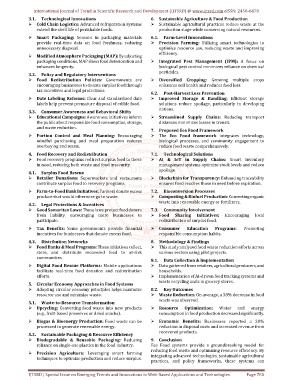Page 790 - Emerging Trends and Innovations in Web-Based Applications and Technologies
P. 790
International Journal of Trend in Scientific Research and Development (IJTSRD) @ www.ijtsrd.com eISSN: 2456-6470
3.1. Technological Innovations 6. Sustainable Agriculture & Food Production
Cold Chain Logistics: Advanced refrigeration systems Sustainable agricultural practices reduce waste at the
extend the shelf life of perishable foods. production stage while conserving natural resources.
Smart Packaging: Sensors in packaging materials 6.1. Farm-Level Innovations
provide real-time data on food freshness, reducing Precision Farming: Utilizing smart technologies to
unnecessary disposal. optimize resource use, reducing waste and improving
efficiency.
Modified Atmosphere Packaging (MAP): By adjusting
packaging conditions, MAP slows food deterioration and Integrated Pest Management (IPM): A focus on
enhances longevity. biological pest control minimizes reliance on chemical
pesticides.
3.2. Policy and Regulatory Interventions
Food Redistribution Policies: Governments are Diversified Cropping: Growing multiple crops
encouraging businesses to donate surplus food through enhances soil health and reduces food loss.
tax incentives and legal protections.
6.2. Post-Harvest Loss Prevention
Date Labeling Reforms: Clear and standardized date Improved Storage & Handling: Efficient storage
labels help prevent premature disposal of edible food. solutions reduce spoilage, particularly in developing
nations.
3.3. Consumer Awareness and Behavioral Shifts
Educational Campaigns: Awareness initiatives inform Streamlined Supply Chains: Reducing transport
the public about responsible food consumption, storage, distances minimizes losses in transit.
and waste reduction.
7. Proposed Eco Food Framework
Portion Control and Meal Planning: Encouraging The Eco Food framework integrates technology,
mindful purchasing and meal preparation reduces biological processes, and community engagement to
overbuying and waste. reduce food waste comprehensively.
4. Food Recovery and Redistribution 7.1. Technological Solutions
Food recovery programs redirect surplus food to those AI & IoT in Supply Chains: Smart inventory
in need, reducing both waste and food insecurity. management systems optimize stock levels and reduce
spoilage.
4.1. Surplus Food Rescue
Retailer Donations: Supermarkets and restaurants Blockchain for Transparency: Enhancing traceability
contribute surplus food to recovery programs. ensures food reaches those in need before expiration.
Farm-to-Food Bank Initiatives: Farmers donate excess 7.2. Bioconversion Processes
produce that would otherwise go to waste. Composting & Biofuel Production: Converting organic
waste into renewable energy or fertilizers.
4.2. Legal Protections & Incentives
Good Samaritan Laws: These laws protect food donors 7.3. Community Involvement
from liability, encouraging more businesses to Food Sharing Initiatives: Encouraging local
participate. redistribution of surplus food.
Tax Benefits: Some governments provide financial Consumer Education Programs: Promoting
incentives for businesses that donate excess food. responsible consumption habits.
4.3. Distribution Networks 8. Methodology & Findings
Food Banks & Meal Programs: These initiatives collect, This study analyzed food waste reduction efforts across
store, and distribute recovered food to at-risk various sectors using pilot projects.
communities. 8.1. Data Collection & Implementation
Digital Food Rescue Platforms: Mobile applications Data gathered from retailers, agricultural producers, and
facilitate real-time food donation and redistribution households.
efforts. Implementation of AI-driven food tracking systems and
waste recycling units in grocery stores.
5. Circular Economy Approaches in Food Systems
Adopting circular economy principles helps maximize 8.2. Key Outcomes
resource use and minimize waste. Waste Reduction: On average, a 38% decrease in food
waste was observed.
5.1. Waste-to-Resource Transformation
Upcycling: Converting food waste into new products Resource Optimization: Water and energy
(e.g., fruit-based preserves or dried snacks). consumption in food production decreased significantly.
Biogas & Bioenergy Production: Food waste can be Economic Benefits: Businesses reported a 20%
processed to generate renewable energy. reduction in disposal costs and increased revenue from
recovered products.
5.2. Sustainable Packaging & Resource Efficiency
Biodegradable & Reusable Packaging: Reducing 9. Conclusion
reliance on single-use plastics in the food industry. Eco Food systems provide a groundbreaking model for
reducing food waste and optimizing resource efficiency. By
Precision Agriculture: Leveraging smart farming
integrating advanced technologies, sustainable agricultural
techniques to optimize production and reduce surplus.
practices, and policy frameworks, these systems can
IJTSRD | Special Issue on Emerging Trends and Innovations in Web-Based Applications and Technologies Page 780

